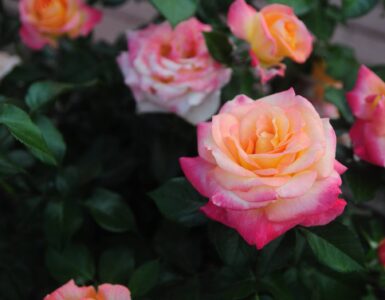Studio 5 Contributor and Utah State University, Consumer Educator, Teresa Hunsaker says it’s cool to can.
At USU Extension we have noticed a renewed interest in canning. Home canning is a great way to preserve food—IF done correctly.
Some methods for canning foods at home have changed greatly since the procedure was first introduced almost two centuries ago. Since then, research has enabled home canners to simplify and safely preserve higher quality foods. Knowing why canning works and what causes food to spoil makes it more obvious as to the importance of following directions carefully.
Canning doesn’t really mean “cans” when it comes to home canning. It involves placing your food in standard canning jars/bottles and heating to a temperature that destroys micro-organisms that cause food to spoil or be unsafe for eating.
When the food is heated it drives air out of the jar and as it cools down it pulls a vacuum seal. This seal also prevents air from getting back in (due to the sealing compound) which could bring micro-organisms back into the jar/bottle.
It does not take long at 212 degrees Fahrenheit (F), the temperature at which water boils at sea level, to force air out, create a vacuum, and seal a jar. It does, however, take a specific amount of heat for a specific amount of time to kill certain bacteria. Although a jar is “sealed,” all bacteria are not necessarily killed. Some micro-organisms are “heat loving” and it takes longer time or higher temperatures to kill them.
Safe Canning Methods
There are two safe ways of processing food, the boiling water bath method and the pressure canner method. Each method has its place depending on the food to be canned. The acidity level, or pH, of foods determines which method to use.
• The boiling water bath method is safe for all high acid foods. Acidity of a food is a very important consideration in whether a food can be safely canned, using the water bath method. Most tomatoes, fruits, jams, jellies, pickles and other preserves are foods that have a pH of 4.6 or lower. (The lower the pH, the more acidic the food. Acidic foods have pH values below 4.6.) In this method, jars of food are heated completely covered with boiling water (212°F at sea level) and cooked for a specified amount of time. High acid foods contain enough acid so that the Clostridium botulinum spores (one of the most concerning of all micro-organisms) cannot grow and produce their deadly toxin. High acidic foods can be safely canned, using the boiling water bath method.
• Pressure canning is the only safe method of preserving vegetables, meats, poultry and seafood. Packed bottles/Jars of food are placed in 2 to 3 inches of water in a special pressure cooker which is heated to a temperature of at least 240° F. This temperature can only be reached using the pressure method. A microorganism called Clostridium botulinum is the main reason why pressure processing is necessary. This particular micro-organism (a spore) is “heat loving” and can withstand boiling temperatures. The spores grow well in low acid foods, and in the absence of air (anaerobic), such as in canned low acidic foods like meats and vegetables. When the spores begin to grow, they produce the deadly botulinum toxin. The only way to destroy these spores is by pressure cooking the food at a temperature of 240°F, or above, for a specified amount of time depending on the type of food and altitude so they don’t produce their toxin. This toxin has no taste, smell, or visible signs of its presence. Foods that are low acid have a pH of number higher than 4.6 and because of the danger of botulism, they must be prepared in a pressure canner.
Low-acid foods do not contain enough acid to prevent the growth of the botulinum bacteria. These foods are processed at temperatures of 240 degrees F to 250 degrees F, attainable with pressure canners operated at 10 to 15 pounds per square inch (psi) of pressure. The exact time depends on the kind of food being canned, the way it is packed in jars, and the size of jars.
Tips for the Boiling Water Bath
1. Canner should be deep enough to allow at least 1 inch of water to cover over the tops of the jars.
2. Get the water heating and almost boiling before adding the jars.
3. Begin processing time when water comes to a boil after the jars are in the canner.
4. A gentle boil is all that is needed for water bath canning—not a hard or over exuberant boil, which causes water to get all over the stove.
5. When time is complete, turn off heat, take the lid off the canner, and remove jars gently to a towel covered counter. (Time will vary depending on altitude.)
Tips for Pressure Canning
1. There should be about 2-3 inches of water in the bottom of the canner—which can be heating prior to adding the filled jars.
2. Be sure to allow for “venting” once the jars are in, the lid in place, and the heat building. Follow manufacturer’s recommendations for time. Most are around 10 minutes of venting steam before closing down the petcock.
3. Start timing when the recommended pressure reading on the gauge has been reached, or the weighted gauge begins to rock. (Pounds pressure will vary depending on altitude.)
4. Keeping pressure regulated to the proper pressure is very important. (If pressure drops below the required amount the time must start over, and fluctuations in pressure of more than a couple of pounds can cause siphoning—liquid loss.)
5. When time is complete turn heat off and allow to cool down on its own. Do not force cooling.
Basic Supplies
Water Bath Canner with rack
Pressure Canner with rack
Standard Canning Jars
Standard Canning Lids/Rings
Jar Lifter
Canning Funnel
Basic kitchen utensils and equipment—saucepans, measuring tools, ladles, etc.
Resources:
Canning Basics by Ohio State University Extension, ohioline.osu.edu/hyg-fact/5000/pdf/5338.pdf
National Center for Home Food Preservation, www.uga.edu/nchfp
Zucchini Relish—Ball Blue Book
2 cups chopped zucchini
1 cup chopped onion
½ cup each red and green pepper, chopped
2 TBS salt
1 ¾ cup sugar
2 tsp celery seed
1 tsp mustard seed
1 c. cider vinegar
Combine zucchini, onion, peppers; sprinkle with salt and cover with cold water. Let stand 2 hours. Rinse and drain. Combine with remaining ingredients in a large saucepan. Bring to a boil and simmer 10 minutes. Pack hot relish into jars, leaving ¼ inch headspace. Remove air bubbles. Wipe down rims. Process 15 minutes (4300-4500 ft. above sea level). Makes approx. 4 half pints.
Taco Sauce—Ball Blue Book
3 cups tomato paste
2 TBS chili powder
1 TBS salt
1 tsp cayenne pepper
½ tsp hot pepper sauce (like Tabasco)
5 c. water
1 c. cider vinegar
½ c. corn syrup
Combine all ingredients in a large saucepan. Bring to a boil. Reduce heat and simmer until thick. As mixture thickens, stir frequently to prevent sticking and scorching. Ladle hot sauce into jars, leaving ¼ inch headspace. Wipe rims of jars clean. Process 40 minutes (4300-4500 ft above sea level) in boiling water bath.
If you have any questions, contact Teresa Hunsaker at the Family and Consumer Science Education Department at the Weber County USU Extension office at (801) 399-8203 or online at www.extension.usu.edu/weber
www.foodinjars.com
www.considerthepantry.com
www.canningacrossamerica.com
www.putsup.com
www.picklefreak.com
http://creativecanning.blogspot.com















Add comment